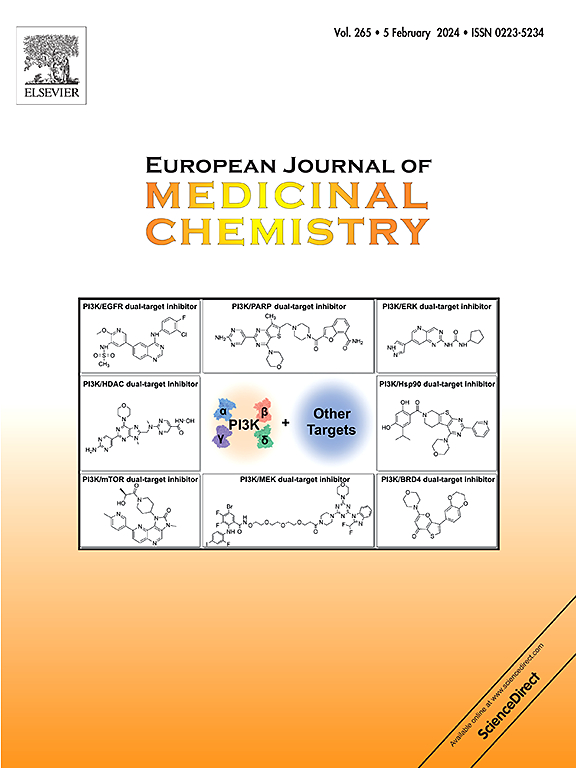“BRAF Inhibitors in Melanoma: Structural Insights, Therapeutic Resistance, and Biological Evaluation of Quinazoline Derivatives.”
IF 6
2区 医学
Q1 CHEMISTRY, MEDICINAL
引用次数: 0
Abstract
The Rapidly accelerated fibrosarcoma (RAF) kinase is important in the MAPK signalling pathway, maintaining various cellular functions, including cell division, metabolism, apoptosis, proliferation, etc. Due to the mutation of BRAF, one of the most prominent isoforms of RAF (a single point mutation), there is approximately a 70-90% chance of developing melanoma. Recent studies found that FDA-approved BRAF inhibitors such as Dabrafenib, Vemurafenib, and Encorafenib acquired resistance towards the therapy (It could be either intrinsic resistance or acquired resistance), furthermore, these candidates are involved in RAS-dependent paradoxical activation of the MAPK pathway. Therefore, the latest generation of chemotherapy drugs is increasingly aimed at targeting the allosteric pocket of BRAF to solve the following challenges. Over the past few years, various heterocyclic scaffolds have been designed to target and inhibit the mutant BRAFV600E regulations. So, in this review, we have analysed the BRAF structure, its activation process, downstream signalling pathway, mutation, the drugs capable of inhibiting the mutant BRAFV600E activity and the therapeutic adherence linked to the FDA-approved medications. We have particularly focused on the recent development of various quinazoline-based compounds with strong evidence covering structure-activity relationship, molecular docking and the key amino acid interactions that guide the researchers to design and synthesize novel Quinazoline analogues as potent BRAF inhibitors.

黑色素瘤中的BRAF抑制剂:结构洞察、治疗耐药性和喹唑啉衍生物的生物学评价。
快速加速纤维肉瘤(RAF)激酶在MAPK信号通路中起重要作用,维持多种细胞功能,包括细胞分裂、代谢、凋亡、增殖等。BRAF是RAF最突出的亚型之一(单点突变),由于BRAF突变,大约有70-90%的几率发生黑色素瘤。最近的研究发现,fda批准的BRAF抑制剂如Dabrafenib、Vemurafenib和Encorafenib对该疗法获得了耐药性(可能是内在耐药性或获得性耐药性),此外,这些候选药物参与ras依赖性MAPK通路的矛盾激活。因此,最新一代化疗药物越来越多地瞄准BRAF的变构口袋,以解决以下挑战。在过去的几年中,各种杂环支架被设计用于靶向和抑制突变体BRAFV600E的调控。因此,在本综述中,我们分析了BRAF结构,其激活过程,下游信号通路,突变,能够抑制突变BRAFV600E活性的药物以及与fda批准的药物相关的治疗依从性。我们特别关注各种喹唑啉类化合物的最新发展,这些化合物具有强有力的证据,包括结构-活性关系,分子对接和关键氨基酸相互作用,这些证据指导研究人员设计和合成新型喹唑啉类似物作为有效的BRAF抑制剂。
本文章由计算机程序翻译,如有差异,请以英文原文为准。
求助全文
约1分钟内获得全文
求助全文
来源期刊
CiteScore
11.70
自引率
9.00%
发文量
863
审稿时长
29 days
期刊介绍:
The European Journal of Medicinal Chemistry is a global journal that publishes studies on all aspects of medicinal chemistry. It provides a medium for publication of original papers and also welcomes critical review papers.
A typical paper would report on the organic synthesis, characterization and pharmacological evaluation of compounds. Other topics of interest are drug design, QSAR, molecular modeling, drug-receptor interactions, molecular aspects of drug metabolism, prodrug synthesis and drug targeting. The journal expects manuscripts to present the rational for a study, provide insight into the design of compounds or understanding of mechanism, or clarify the targets.

 求助内容:
求助内容: 应助结果提醒方式:
应助结果提醒方式:


